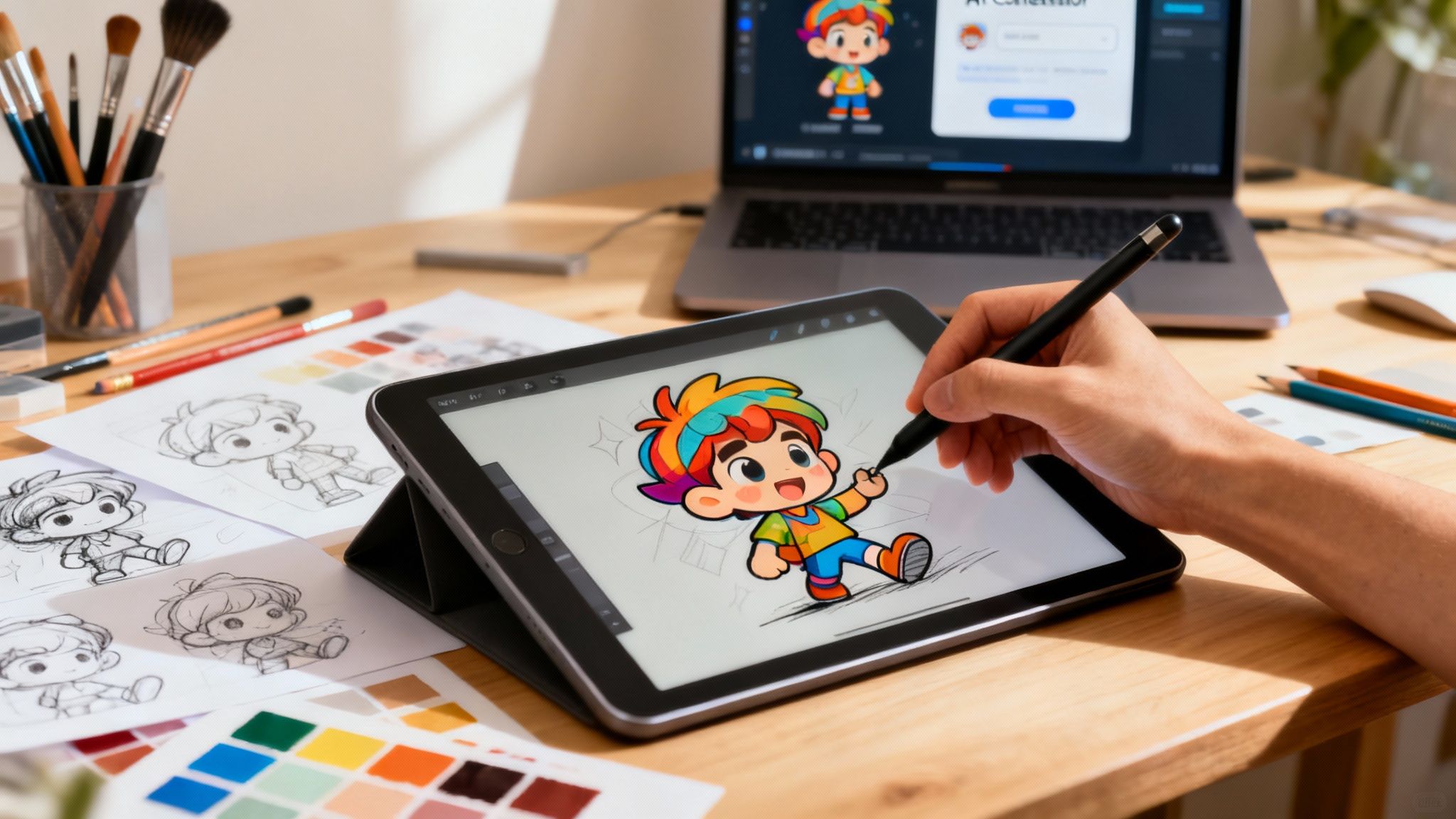
You've spent hours, maybe even days, creating a killer piece of content. You hit publish, sit back, and wait for the flood of traffic... but it's just a trickle. What went wrong? The hard truth is that a weak headline is likely sabotaging your efforts. For digital marketers and content creators, mastering how to write headlines is not just a skill—it's the gatekeeper to your entire strategy. If your headline doesn't grab your audience, all the valuable work you did on the article goes completely unnoticed. This guide breaks down the proven formulas and psychological triggers to help you craft headlines that stop the scroll and turn casual browsers into engaged readers, every single time.
Why Your Headlines Are Costing You Readers
Think of your headline as a promise to your reader. It's your one shot to convince them that what's inside is worth their time. The data doesn't lie: on average, 8 out of 10 people will read your headline, but a shocking 2 out of 10 will actually click through to read the rest.
That single sentence is the gatekeeper to your entire article. A boring or vague headline means you’re losing traffic, engagement, and potential customers before they even have a chance to see what you have to offer.
This guide isn't about tossing out a few generic tips. We're going to break down the psychology of what makes people stop scrolling and actually click. I'll share some proven formulas and actionable strategies that will help you turn casual browsers into engaged readers, every single time.

The Psychology Behind a Compelling Headline
The best headlines aren't just clever wordplay; they're rooted in human psychology. To write headlines that people have to click, you need to go beyond words and tap into the cognitive triggers that drive our decisions. A powerful headline connects with a core need, a deep-seated fear, or an urgent desire, making the reader feel like you're speaking directly to them and their challenges. This is where the real work begins—not with a thesaurus, but with a genuine understanding of your audience.

Create a Curiosity Gap
One of the most potent tools in your arsenal is the curiosity gap. It’s the space between what someone knows and what they desperately want to find out. A great headline opens this gap by presenting a tantalizing piece of information while strategically holding back the full story. For instance, a marketing agency could use a headline like, "The One Mistake 90% of Startups Make in Their First Year." The reader immediately wonders, what's the mistake? Their brain is hardwired to close that loop, making a click almost instinctual. Treat your headline like a movie trailer—hint at the incredible value inside without giving away the ending.
Instill Urgency and Scarcity
Ever heard of FOMO (fear of missing out)? It’s a powerful motivator. We're wired to avoid loss, and the thought of missing a crucial opportunity often pushes us to act faster than the promise of a potential gain. Headlines that tap into this create an urgent need for action.
You can spark this feeling in a few ways:
- Use timely words: Phrases like "Right Now," "Before It's Too Late," or "The 2024 Update" make the information feel immediately relevant.
- Frame it as exclusive knowledge: A headline like, "What Top Marketers Know About AI (That You Don't)" creates a desire to join an in-the-know group.
- Show the cost of doing nothing: Something like, "Why Your Content Strategy Is Failing (And How to Fix It)" implies that ignoring your advice comes with real, negative consequences.
A solid grasp of advertising and psychology will give you a serious edge here. These two fields are deeply intertwined, and understanding them helps you craft messages that truly connect.
Leverage Social Proof and Authority
As humans, we're social creatures. We constantly look to others for cues on how to behave and what to trust. This is the power of social proof. When your headline signals that other people have already found value in your content, it instantly builds credibility and lowers the reader's risk of wasting their time. A headline like, "11,387 Marketers Agree: This Is the Best Way to Write Headlines" feels like a sure thing. It says, "Hey, thousands of your peers have already vetted this for you."
Here are a few ways to bake social proof into your headlines:
- Use big numbers: Mention subscriber counts, downloads, or survey results.
- Cite an authority figure: "A Google Engineer Explains How to Triple Your Site Speed."
- Hint at a success story: "How One Freelancer Doubled Her Income with This Simple Tactic."
Actionable Headline Formulas You Can Adapt
Okay, so you get the psychology behind what makes people click. But how do you actually turn that theory into a killer headline, time and time again? This is where headline formulas come into play. Don't think of them as strict rules. Instead, see them as battle-tested frameworks you can lean on to break through writer's block and build every headline on a foundation that works. These formulas are effective because they shortcut right to the psychological triggers we've been talking about, packaging them in a way that feels right to readers.

The Undeniable Power of Listicles
There's a reason you see numbered headlines everywhere: they work. A headline like "7 Ways to Use AI in Your Content Workflow" makes a crystal-clear promise to the reader. They know exactly what they're getting—the format, the length, and the value. It's all about eliminating uncertainty. Our brains crave order, and listicles deliver. For a busy creator or marketer, a scannable list is a huge win. Some studies even show listicles can boost page views by as much as 80%. Using odd numbers often feels more authentic and can give you an edge in click-through rates.
How-To Guides That Actually Solve a Problem
The "how-to" headline is a content marketing classic. It directly targets a reader's pain point and offers a clear path to a solution. When someone is searching for a solution, your headline needs to be the beacon that says, "I've got the answer." But don't just stop at "How to Write Headlines." You need to be more specific and dangle the benefit. Try something like "How to Write Headlines That Convert (Without Sounding Like a Robot)." See the difference? It nails the goal (conversion) while also hitting on a common fear (sounding generic).
Benefit-Driven vs. Question-Based Headlines
While a "how-to" focuses on the process, a benefit-driven headline zeroes in on the outcome. It answers that silent question every reader has: "What's in it for me?" A title like "The 5-Minute Guide to Reaching a Zero-Inbox" is incredibly powerful. It highlights a massively desirable result (a clean inbox) and crushes the biggest objection (not enough time). Questions work a bit differently. A headline like "Are You Making These Common SEO Mistakes?" makes people pause and reflect. It creates an itch they have to scratch by clicking to see if they're guilty. This same curiosity-driven approach is key on social media, too. You can see great examples of this in action when learning how to write tweets that get noticed.
Using AI to Generate and Test Headlines
Let's be honest. Manually crafting the perfect headline can be a grind. You know the formulas and the psychology, but some days the creative spark just isn't there. This is exactly where AI stops being a buzzword and becomes your most valuable brainstorming partner. Instead of staring at a blank page, you can feed an AI tool a core topic or a rough title and get dozens of variations back in seconds. This isn't about replacing your strategic mind; it's about amplifying it, showing you new angles and structures you might not have landed on otherwise.

Brainstorming at Scale with AI
Think of AI as a creative accelerant. A content marketer might have a solid, keyword-rich idea like, "How Agencies Can Use Automation to Scale Content Production." It's functional, sure, but it might not have the punch needed to cut through the noise. By plugging this into a tool like MediaWorkbench.ai, you can get a whole menu of options tailored to different channels, almost instantly.
- For a blog post (SEO-focused): "The Ultimate Guide to Scaling Agency Content with Automation"
- For a LinkedIn article (Benefit-driven): "Stop Drowning in Content: How Top Agencies Use Automation to Scale"
- For a Twitter post (Punchy and direct): "Your agency is wasting hours on content. Here's how automation fixes it. 🧵"
In just a few moments, one idea is transformed into the foundation of a multi-channel campaign. This process helps you smash through creative blocks and ensures you have a headline perfectly suited for every platform. You can explore a variety of top AI brainstorming tools to see which one fits your specific workflow best.
The Human and AI Partnership
The most effective approach isn't to just let AI take the wheel. Your expertise as a marketer—your deep understanding of your audience's pain points, your brand's voice, and your campaign's goals—is irreplaceable. AI provides the raw material and the data; you provide the final strategic filter. It handles the repetitive, time-consuming work of brainstorming and testing, which frees you up to focus on the big-picture strategy. Learning how to use AI for marketing is all about this powerful combination of human insight and machine efficiency. The end result? Headlines that don't just get seen—they get results.
👉 Try MediaWorkbench.ai for free – schedule your posts and generate AI content in one place!
Optimizing Headlines for Search and Social
Writing a headline that grabs a reader’s attention is only half the job. For your content to truly take off, the headline also needs to play nice with the algorithms on Google and social media. It's a balancing act—you’re writing for people and platforms at the same time. Think of your SEO headline as the solid foundation, signaling to Google exactly what your content is about. On the other hand, social media is all about stopping the scroll. Here, the emotional hook, tone, and even the length of your headline are everything.
Writing Headlines for SEO Success
When you're optimizing for search engines, you're playing by Google's rules. The biggest one? Character count. Google usually only shows the first 50–60 characters of a title tag in its search results. Go any longer, and your brilliant headline gets awkwardly cut off. To get that coveted click, your headline needs to make a clear promise. Headlines with numbers are 36% more likely to get clicked. A title like "7 Ways to Improve Your Content Strategy" is just so much more tangible than "How to Improve Your Content Strategy."
- Front-load your keyword: Get your main keyword in there right at the start.
- Watch your length: Keep it under 60 characters to avoid getting cut off.
- Be specific: "How to Write Headlines" is okay, but "How to Write Headlines That Drive Clicks" is way better because it clearly states the benefit.
Adapting Headlines for Social Media
On social media, the game changes completely. SEO headlines are built for clarity and keywords; social headlines are all about sparking curiosity and conversation. What works on one platform can fall flat on another. For example, a professional, question-based headline like "Are Marketers Overlooking This Headline Strategy?" often does well on LinkedIn by inviting experts to weigh in. But on Twitter, you need something punchy and direct to cut through the noise. Knowing how to write compelling Instagram post captions is also essential, as the principles of creating a hook and delivering value remain the same.
Master the Art of the Headline
Knowing how to write headlines is a crucial skill for any content creator, marketer, or agency. It’s the difference between content that gets seen and content that gets ignored. By understanding the psychology behind a click, using proven formulas, and leveraging AI tools, you can move beyond guesswork. Remember to create a curiosity gap, instill urgency, and use social proof to build trust. Test your headlines for both SEO and social media to see what truly resonates with your audience. Ultimately, a great headline isn't just written; it's engineered to capture attention and drive action. Ready to put these tips into practice? Start creating more powerful content with MediaWorkbench.ai and watch your engagement soar.
Ready to generate dozens of headline variations in seconds? Let Media Workbench AI do the heavy lifting. Our AI-powered tools help you brainstorm, refine, and optimize headlines that capture attention and drive results. Start creating compelling content today at https://mediaworkbench.ai.

